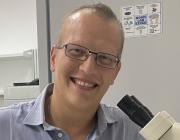Abstract:
The fumarylacetoacetate hydrolase (FAH) protein superfamily of metabolic enzymes comprises a diverse set of enzymatic functions, including ss-diketone hydrolases, decarboxylases, and isomerases. Of note, the FAH superfamily includes many prokaryotic members with very distinct functions that lack homologs in eukaryotes. A prokaryotic member of the FAH superfamily, referred to as Cg1458, was shown to encode a soluble oxaloacetate decarboxylase (ODx). Based on sequence homologies to Cg1458, we recently identified human FAH domain containing protein-1 (FAHD1) as the first eukaryotic oxaloacetate decarboxylase. The physiological functions of ODx in eukaryotes remain unclear. Here we have probed the function of fahd-1, the nematode homolog of FAHD1, in the context of an intact organism. We found that mutation of fahd-1 resulted in reduced brood size, a deregulation of the egg laying process and a severe locomotion deficit, characterized by a reduced frequency of body bends, reduced exploratory movements and reduced performance in an endurance exercise test. Notably, mitochondrial function was altered in the fahd-1(tm5005) mutant strain, as shown by a reduction of mitochondrial membrane potential and a reduced oxygen consumption of fahd-1(tm5005) animals. Mitochondrial dysfunction was accompanied by lifespan extension in worms grown at elevated temperature; however, unlike in mutant worms with a defect in the electron transport chain, the mitochondrial unfolded protein response was not upregulated in worms upon inactivation of fahd-1. Together these data establish a role of fahd-1 to maintain mitochondrial function and consequently physical activity in nematodes.
Notes:
Taferner, AndreaPircher, HaymoKoziel, Rafalvon Grafenstein, SusanneBaraldo, GiorgiaPalikaras, KonstantinosLiedl, Klaus RTavernarakis, NektariosJansen-Durr, PidderengP40 OD010440/OD/NIH HHS/Research Support, Non-U.S. Gov'tPLoS One. 2015 Aug 12;10(8):e0134161. doi: 10.1371/journal.pone.0134161. eCollection 2015.

